Articles
- Page Path
- HOME > Korean J Community Nutr > Volume 25(5); 2020 > Article
- Research Article
- Current Status of Sanitary and Nutritional Food Service in Elderly Day Care Center
- Jeong hyeon Woo, Yoo Kyoung Park, Mi-Hyun Kim, Soo-Kyung Lee, Kyung hee Song, Hye-Kyeong Kim
-
Korean Journal of Community Nutrition 2020;25(5):374-385.
DOI: https://doi.org/10.5720/kjcn.2020.25.5.374
Published online: October 31, 2020

2Professor, Dept. of Medical Nutrition, Graduate School of East-West Medical Science, Kyung Hee University, Yongin, Korea

3Professor, Division of Food Science, Kongju National University, Yesan, Korea

4Professor, Dept. of Food and Nutrition, Inha University, Incheon, Korea

5Professor, Dept. of Food and Nutrition, Myongji University, Yongin, Korea

6Professor, Dept. of Food Science & Nutrition, The Catholic University of Korea, Bucheon, Korea

-
Corresponding author:
Hye-Kyeong Kim,
Email: hkyeong@catholic.ac.kr
- 120 Views
- 0 Download
- 5 Crossref
- 0 Scopus
Abstract
Objectives
This study was conducted to examine the status of foodservice management, with special interest on sanitary and nutritional food service in elderly day care centers.
Methods A total of 79 employees who managed foodservice facilities in elderly day care centers were included in the survey. The contents of the questionnaire consisted of general characteristics, importance and performance of sanitary and nutrition management, the reasons for poor performance, factors necessary for improvement, and the employee's demand for support. Data analysis was conducted using the SPSS v25.0.
Results Sanitary management showed an average importance score of 4.84 ± 0.40 and a performance score of 4.70 ± 0.61 (t-value: 8.260). The item with the lowest performance score was personal sanitary management (4.58 ± 0.71). In nutrition management, the average importance score was 4.52 ± 0.68, and the performance score was 4.20 ± 1.00 (t-value: 9.609). There were significant differences between the average score of importance and performance in both areas. As a result of an Importance-Performance Analysis, items that were recognized as important but had relatively low performance was “personal hygiene”, “ventilation” and “food storage”. Also in the nutritional management area, “menu planning for disease management” and “checking the saltiness in the soup” etc. had very low performance with low importance recognition. The items shown in the “low priority” quadrant were those that required professional management skills. In the areas that demanded support in foodservice management, education about sanitary and safe institutional food service had the highest score (4.42 ± 0.74), and all other items showed a demand of 4 points or more.
Conclusions Foodservice managers recognize the importance of foodservice facility management but performance is relatively low. Institutional support is, therefore, needed to improve performance. For items with low importance, it seems necessary to improve awareness of the necessity of these items and to provide education in this regard. To gradually improve foodservice management, continuous provision of education and training in these areas are of great importance.
Published online Oct 31, 2020.
https://doi.org/10.5720/kjcn.2020.25.5.374
Current Status of Sanitary and Nutritional Food Service in Elderly Day Care Center
Abstract
Objectives
This study was conducted to examine the status of foodservice management, with special interest on sanitary and nutritional food service in elderly day care centers.
Methods
A total of 79 employees who managed foodservice facilities in elderly day care centers were included in the survey. The contents of the questionnaire consisted of general characteristics, importance and performance of sanitary and nutrition management, the reasons for poor performance, factors necessary for improvement, and the employee's demand for support. Data analysis was conducted using the SPSS v25.0.
Results
Sanitary management showed an average importance score of 4.84 ± 0.40 and a performance score of 4.70 ± 0.61 (t-value: 8.260). The item with the lowest performance score was personal sanitary management (4.58 ± 0.71). In nutrition management, the average importance score was 4.52 ± 0.68, and the performance score was 4.20 ± 1.00 (t-value: 9.609). There were significant differences between the average score of importance and performance in both areas. As a result of an Importance-Performance Analysis, items that were recognized as important but had relatively low performance was “personal hygiene”, “ventilation” and “food storage”. Also in the nutritional management area, “menu planning for disease management” and “checking the saltiness in the soup” etc. had very low performance with low importance recognition. The items shown in the “low priority” quadrant were those that required professional management skills. In the areas that demanded support in foodservice management, education about sanitary and safe institutional food service had the highest score (4.42 ± 0.74), and all other items showed a demand of 4 points or more.
Conclusions
Foodservice managers recognize the importance of foodservice facility management but performance is relatively low. Institutional support is, therefore, needed to improve performance. For items with low importance, it seems necessary to improve awareness of the necessity of these items and to provide education in this regard. To gradually improve foodservice management, continuous provision of education and training in these areas are of great importance.
Fig. 1
Importance-Performance Analysis of foodservice sanitary management items
Fig. 2
Importance-Performance Analysis of foodservice nutrition management items
Table 1
General characteristics of the facilities surveyed (n=79)
Table 2
Importance-Performance Analysis for the sanitary management in elderly day care centers
Table 3
Reasons for low performance and factors related to improvement of sanitary management
Table 4
Importance-Performance Analysis for the nutrition management in elderly day care centers
Table 5
Reasons for low performance and factors related to improvement of nutrition management
Table 6
Needs assessment for the foodservice management in elderly day care centers
Acknowledgments
This research was supported by a grant from the 2019 Korea Federation of Women's Science & Technology Association.
References
-
Ministry of Health and Welfare. 2019 Information of elderly health and welfare business [internet]. Ministry of Health and Welfare; 2019 [cited 2020 Apr 21].Available from: https://www.mohw.go.kr/react/jb/sjb030301vw.jsp?PAR_
MENU_ ID=03&MENU_ ID=032901&CONT_ SEQ=349225.
-
-
Korean Statistical Information Service. Number of facilities for the aged welfare and life status [internet]. Korean Statistical Information Service; 2019 [cited 2020 Jul 7].
-
-
Choi YO. Status and development direction of in-home elderly welfare services. Asia Pac J Multimed Serv Converg Art Humanit Soc 2019;9(7):845–854.
-
-
Chung KH. In: 2017 National survey of the living conditions and welfare needs of older Koreans. Ministry of Health and Welfare; 2017 Jul.Report No. Policy Report 2017-53.
-
-
Ministry of Food and Drug Safety. Guidelines for healthy meals for the elderly [internet]. Ministry of Food and Drug Safety; 2015 [cited 2020 May 1].Available from: https://www.mfds.go.kr/brd/m_
228/view.do?seq=21193.
-
-
Kim SH, Kang HK, Kim JH. Socio-economic factors affecting the health and nutritional status of the aged. Korean J Nutr 2000;33(1):86–101.
-
-
Kim KR, Hong SA, Kim MK. Nutritional status and food insufficiency of Korean population through the life-course by education level based on 2005 national health and nutrition survey. J Nutr Health 2008;41(7):667–681.
-
-
Choi JH, Lee YJ, Lee ES, Lee HS, Chang HJ, Lee KE. Investigation of food safety knowledge, attitudes, and behavior for analyzing food safety risk factors in the elderly. J Korean Soc Food Sci Nutr 2016;45(5):746–756.
-
-
Seo SH, Yun NR. Foodservice management and food safety knowledge and practices of employees in elderly welfare facilities. J Korean Diet Assoc 2011;17(3):287–301.
-
-
Park DJ, Jung SM. A study on care-givers in home service of long-term care in providing nutrition for their beneficiaries. Korean Aging Friendly Assoc 2019;11(1):47–56.
-
-
Seo SH, Moon SJ, Choi JH. Evaluation of hygienic status using ATP bioluminescence assay and food service workers' sanitation performance in elderly welfare facilities. J Korean Diet Assoc 2011;17(2):142–160.
-
-
Seo JE, Kwon KI, Kim GH. Study on the actual conditions of institution foodservice management in the elderly welfare facilities by the employment of dietitians. Korean J Food Cook Sci 2019;35(2):216–225.
-
-
Han GS, Yang EJ. Status of foodservice operations in long-term care facilities for the elderly-focus on the Gwangju metropolitan city. J East Asian Soc Diet Life 2018;28(5):337–344.
-
-
Ministry of Government Legislation. Enforcement rule of the act on welfare of senior citizens [internet]. Ministry of Government Legislation; 2020 [cited 2020 Apr 14].Available from: http://www.law.go.kr/%EB%B2%95%EB%A0%B9/%EB%85%B8%EC%9D%B8%EB%B3%B5%EC%A7%80%EB%B2%95%EC%8B%9C%ED%96%89%EA%B7%9C%EC%B9%99.
-
-
Martilla JA, James JC. Importance-performance analysis. J Mark 1977;41(1):77–79.
-
-
Lee MJ, Kim JH, Park OJ, Lee YM. A study on the needs for nutrition management program for elderly who use welfare facilities. Korean J Community Nutr 2016;21(1):65–74.
-
-
Bae HJ. Analysis of contamination of bacteria from raw materials, utensils and workers' hands to prepared foods in foodservice operations. J Korean Soc Food Sci Nutr 2006;35(5):655–660.
-
-
Kim SH, Kang HK, Kim JH. Socio-economic factors affecting the health and nutritional status of the aged. J Nutr Health 2000;33(1):86–101.
-
-
Yoon MO, Moon HK, Kim SY, Kim BH. Nutritional assessment and management in long-term care insurance's home visit care service. Korean J Community Nutr 2013;18(2):142–153.
-
-
Yang IS, Jung HY, Lee HY, Chae IS. Analyzing the current practice of the home-delivered meal (HDM) service program for homebound elderly. Korean J Community Nutr 2003;8(5):736–743.
-
-
Bae JS, Kim MH, Kim SB. Effects of nutrition education and personalized lunch service program for elderly at senior welfare center in Jeonju. Korean J Community Nutr 2013;18(1):65–76.
-
-
Kim HR. Present of institution foodservice and nutrition management improvement task. Health Welf Issue Focus 2012;130:1–8.
-
-
Choi JH, Kim DH, Choi EH, Chung MJ, Lee HS, Lee MJ, et al. Assessment of foodservice management practices according to types of elderly foodservice facilities. J Korean Soc Food Sci Nutr 2019;48(4):469–481.
-

 KSCN
KSCN
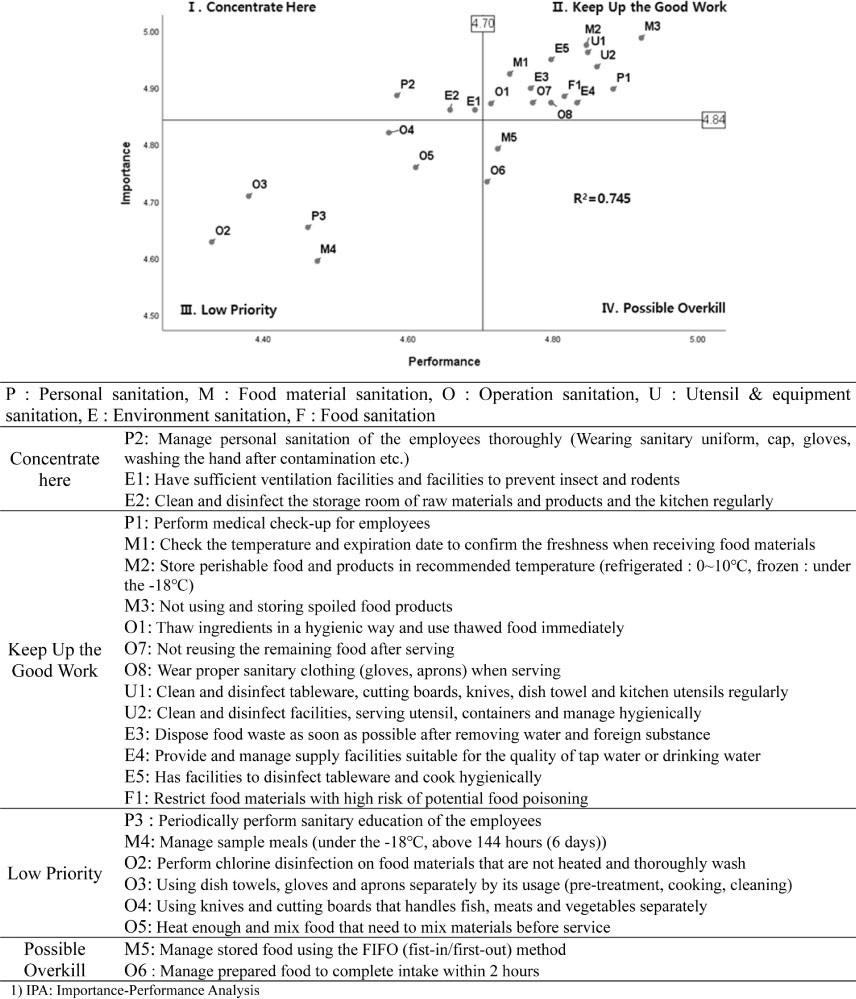
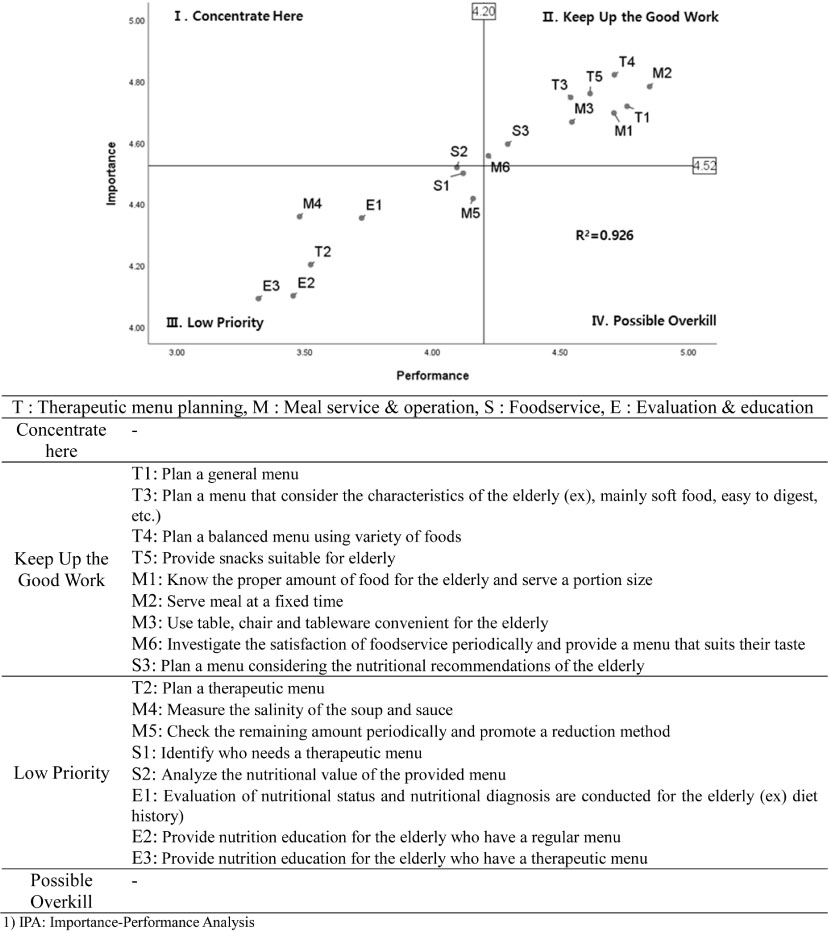

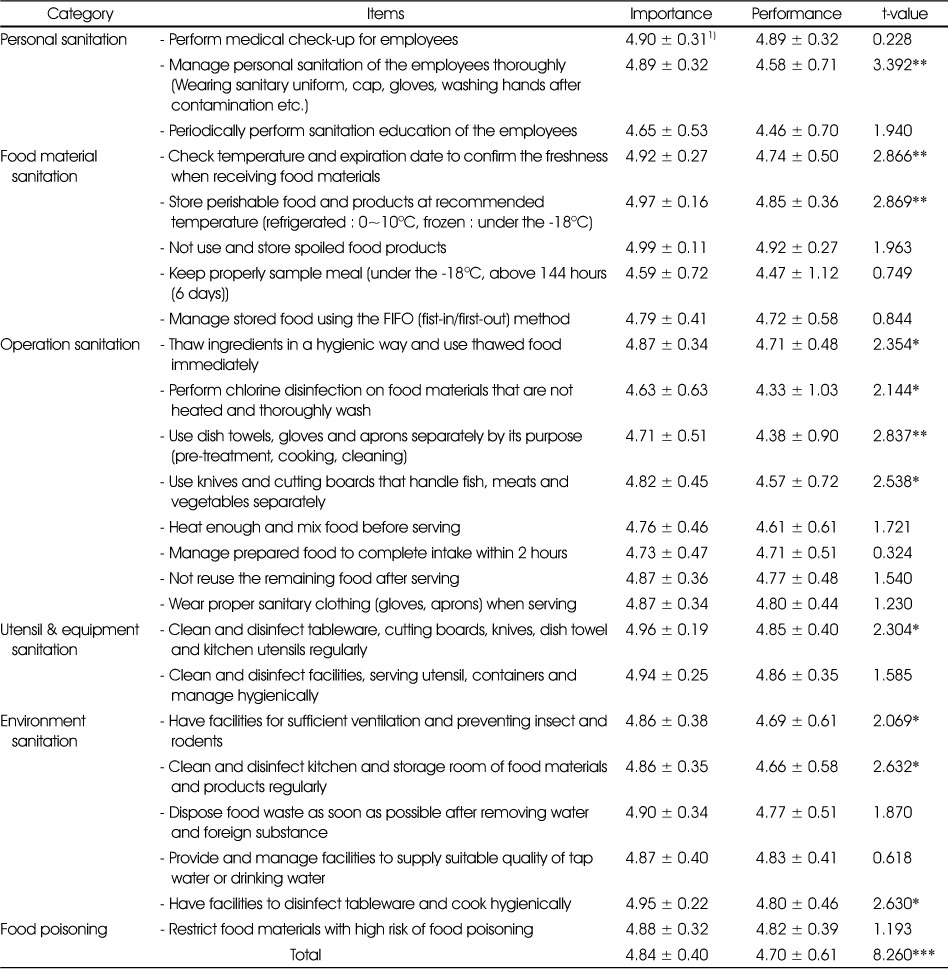
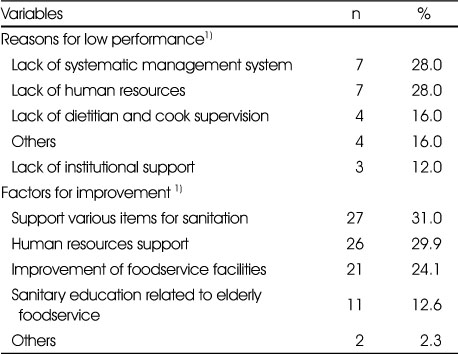
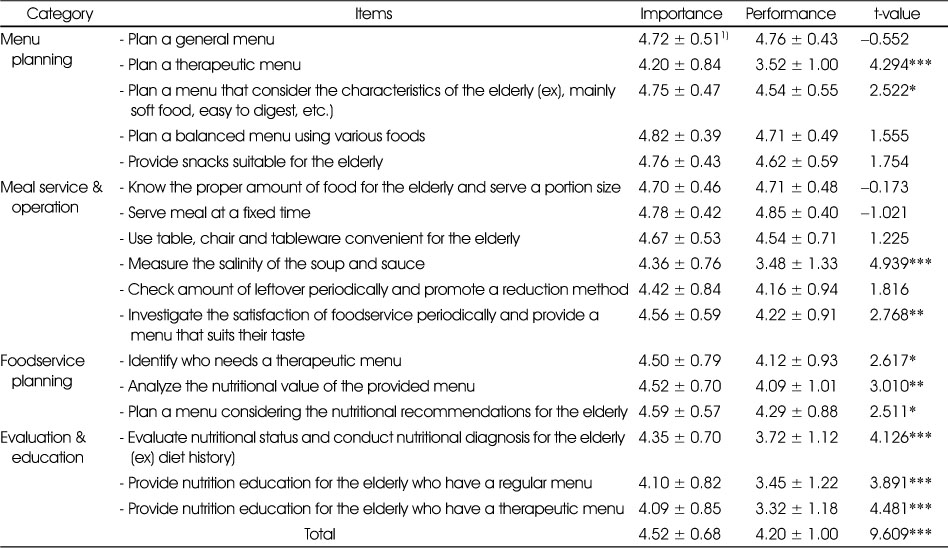
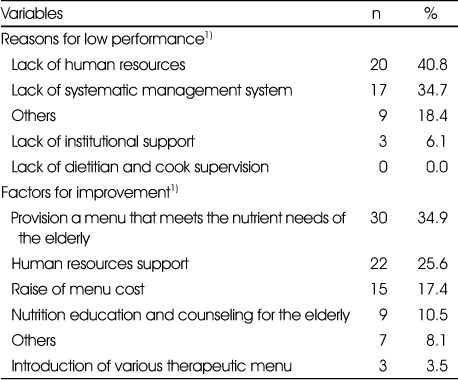


 Cite
Cite


